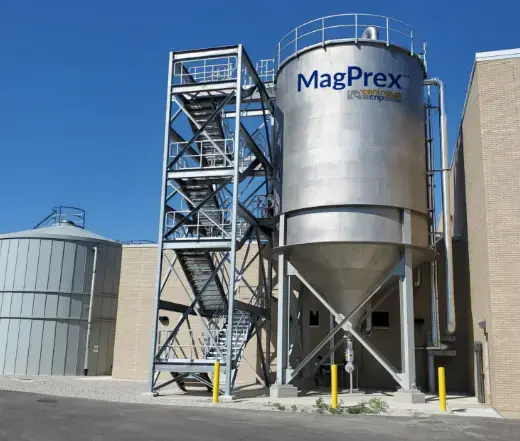THK Sludge Thickener
The THK sludge thickener from Centrisys is designed to thicken waste-activated sludge with little or no polymer. The system produces up to 8 percent cake solids running at flow rates of up to 1,000 gpm. Applications include secondary sludge, primary sludge, oxidation ditch sludge, digested sludge and MBR sludge.
“Depending on the sludge, the characteristics and the demand of the plant, we have the option to run no polymer, or if there’s a scenario where a plant doesn’t want to run three machines or one is down for maintenance, we eliminate the third redundancy by injecting a low dosage of polymer and diverting full flow through a single machine,” says Andre Adams, chief engineer in research and development of the THK Sludge Thickener. “We can expand the capacity of one machine 150 to 200 percent using 1 to 2 pounds of polymer.”
The thickener is available in three models. The 18-inch model is designed to process up to 200 gpm, the 21-inch can process up to 400 gpm and the 26-inch can process up to 1,000 gpm (650 gpm without polymer), depending on the sludge and characteristics. The system occupies a footprint that’s up to 90 percent smaller than traditional technologies. One THK 18-3 sludge thickener replaces two DAF systems (5,000 square feet).
“While we have processed that amount in the past, we’re now able to do it with smaller machines, less power consumption and reduced polymer costs,” Adams says.
Suitable for new plant construction and retrofits, the thickening centrifuge also eliminates odors and provides added flexibility over other technologies.
“If you’re in a plant where they don’t like the smell, and that’s a big factor, because unless you get a fully enclosed gravity belt thickener it’s open to the atmosphere. It’s smelly, and some people don’t like that,” says Bob Harvin, technical director for Centrisys. The airtight centrifuge system eliminates odors and aerosols, reducing operator exposure to process liquids and vapors.
“The thickener also offers a much wider range of controllable cake solids,” he says. “We can do anywhere from 3 to 10 percent on the sludges, which really depends on flow rate. You’re not going to get the driest cake, the highest capacity and the best recovery at the same time. Everything’s a trade-off. What this enables you to do is bend and change as you go forward. If you’re going to the new energy initiatives, you probably want to go to different cake solids.”
